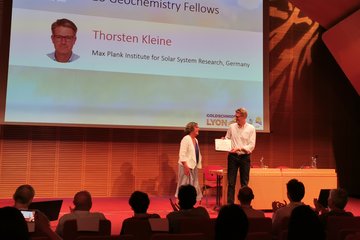Alle Typen
1.
Zeitschriftenartikel
The Scientific Calibration of the Dawn Framing Camera. Space Science Reviews 220, S. 4 (2024)
2.
Zeitschriftenartikel
Moons and Jupiter Imaging Spectrometer (MAJIS) on Jupiter Icy Moons Explorer (JUICE). Space Science Reviews 220, S. 27 (2024)
3.
Zeitschriftenartikel
Moons and Jupiter Imaging Spectrometer (MAJIS) on Jupiter Icy Moons Explorer (JUICE). Space Science Reviews 220, S. 27 (2024)
4.
Zeitschriftenartikel
New Candidates for Organic-rich Regions on Ceres. The Planetary Science Journal 5, S. 262 (2024)
5.
Zeitschriftenartikel
The young resurfacing events at Ceres' Occator Crater: Seismic shaking or deposition of cryovolcanic material? Icarus 389, S. 115259 (2023)
6.
Zeitschriftenartikel
The young resurfacing events at Ceres' Occator Crater: Seismic shaking or deposition of cryovolcanic material? Icarus 389, S. 115259 (2023)
7.
Zeitschriftenartikel
Science Drivers for the Future Exploration of Ceres: From Solar System Evolution to Ocean World Science. The Planetary Science Journal 3, S. 64 (2022)
8.
Zeitschriftenartikel
Geology and colour of Kupalo crater on Ceres. Planetary and Space Science 220, S. 105538 (2022)
9.
Zeitschriftenartikel
Brine residues and organics in the Urvara basin on Ceres. Nature Communications 13, S. 927 (2022)
10.
Zeitschriftenartikel
GAUSS - genesis of asteroids and evolution of the solar system: A sample return mission to Ceres. Experimental Astronomy (2021)
11.
Zeitschriftenartikel
Recent cryovolcanic activity at Occator crater on Ceres. Nature astronomy 4 (8), S. 794 - 801 (2020)
12.
Zeitschriftenartikel
Impact-driven mobilization of deep crustal brines on dwarf planet Ceres. Nature astronomy 4 (8), S. 741 - 747 (2020)
13.
Zeitschriftenartikel
Impact heat driven volatile redistribution at Occator crater on Ceres as a comparative planetary process. Nature Communications 11 (1), 3679 (2020)
14.
Zeitschriftenartikel
Hydrological evolution of Occator crater: Implications from pingo and frost heave morphology. (eingereicht)
15.
Zeitschriftenartikel
Post-impact cryo-hydrologic formation of small mounds and hills in Ceres’s Occator crater. Nature Geoscience 13 (9), S. 605 - 610 (2020)
16.
Zeitschriftenartikel
Landslides on Ceres: Inferences Into Ice Content and Layering in the Upper Crust. Journal of Geophysical Research: Planets 124 (6), S. 1512 - 1524 (2019)
17.
Zeitschriftenartikel
Exposed H2O-rich areas detected on Ceres with the dawn visible and infrared mapping spectrometer. Icarus 318, S. 22 - 41 (2019)
18.
Zeitschriftenartikel
Landslides on Ceres: Diversity and Geologic Context. Journal of Geophysical Research: Planets 124 (12), S. 3329 - 3343 (2019)
19.
Zeitschriftenartikel
Spectrophotometric modeling and mapping of Ceres. Icarus 322, S. 144 - 167 (2019)
20.
Zeitschriftenartikel
Unique Light Scattering at Occator's Faculae on (1) Ceres. Astronomical Journal 158 (2), 85 (2019)











